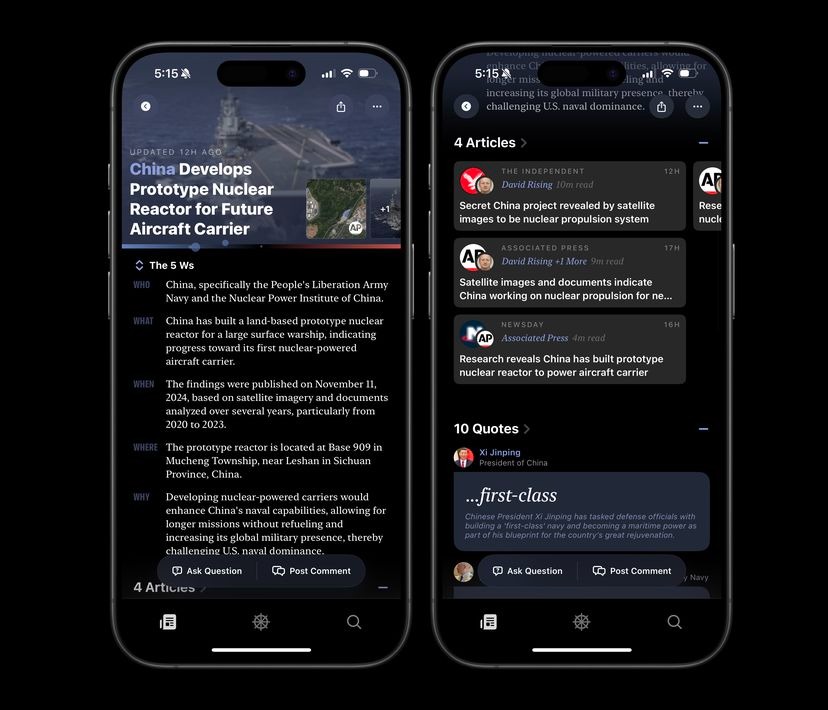It’s a complicated time for online news. Traditional challenges—like threats to First Amendment rights, shifts in platform algorithms that reduce traffic, and the complexities of a changing ad landscape—are all compounded by the rapid rise of AI. With powerful AI systems now pulling content from across the internet and repackaging it as simplified, often half-true summaries, keeping the quality of news high has become even more challenging. In response to this shifting landscape, a new platform called Particle has emerged, designed by two former Twitter product leaders. Their mission? To make news easier to find and understand, with AI playing a central role in the process.
Particle aims to use AI for two primary functions. The first is organizing news content into “Stories,” where articles and coverage on a single topic are compiled into one resource, providing a wealth of perspectives and facts. Some “Stories” can include over 100 news articles, related posts from X (formerly Twitter), and a selection of key quotes, all collected to offer readers a deep dive into any given topic. The goal is to provide more context, making complex news topics more accessible by gathering diverse sources in one place.
The second feature is summarization. At the top of each “Story” page, Particle uses AI to distill the content into concise bullet points, similar to summaries you’d see from tools like ChatGPT. Additionally, users can modify the summary style to suit their needs. For instance, choosing “Opposite Sides” provides a comparison of two opposing viewpoints on a topic—such as debates around Trump’s proposed cabinet—while “Explain Like I’m 5” simplifies current events, like the Gaza conflict, to the most basic terms. Particle even lets users adjust headlines for clarity, humor, or simplicity, though the results may vary. Users can also interact with an AI bot, asking questions to get direct answers about topics of interest.
Particle integrates this AI-powered organization and summarization throughout its interface. New users begin by swiping through headlines to indicate topics they want to see more (or less) of in their personalized feed. Users can also follow specific journalists or publications to elevate their content. Moreover, Particle’s AI tries to identify the political leanings of each article and publisher to offer balanced coverage, flagging biased reporting and helping users find a diverse set of views.

In design and functionality, Particle is polished and dense with information. Early beta testers report that it offers a quick, effective way to grasp the essential points of significant news stories. However, Particle isn’t the first app to attempt such an ambitious approach to news aggregation and summarization. Platforms like Circa, which attempted to aggregate news into concise updates, struggled to capture a lasting audience. Other apps, such as Discors, experimented with structuring news to provide context but failed to gain traction. Even giants like Snapchat and Facebook once dabbled in news aggregation, only to abandon those initiatives when user interest waned. The challenge is clear: there’s little evidence that apps focused solely on news curation can sustain themselves long-term.
Yet, the Particle team is well aware of these past challenges. CEO Sara Beykpour, a former Twitter executive, brings a decade of experience in managing online information flow, while her co-founder Marcel Molina has extensive experience working on Twitter’s timeline. Both founders believe AI can now do what previous news apps could not—effectively process and present information at a massive scale with greater accuracy. Particle claims to have found ways to reduce AI’s well-documented issues, like hallucinations and inaccuracies, partly by incorporating human editorial oversight. To strengthen its news offerings, Particle has secured content-sharing agreements with notable publishers, including Reuters, Time, and Fortune. These partnerships will be essential for Particle to offer reliable news and differentiate itself from other platforms.
In a time when the internet is flooded with both information and misinformation, distinguishing fact from fiction has become more challenging. Particle’s approach, with its focus on curated content and user-adjustable summaries, aims to bring clarity to a chaotic information landscape. The team is optimistic that their platform can strike a balance between news accessibility and accuracy, filling a gap that many other news apps have tried and failed to fill. As the next election cycle approaches, and with people increasingly seeking reliable, balanced information, Particle hopes its AI-driven approach will meet users’ needs for clear, trustworthy news.
